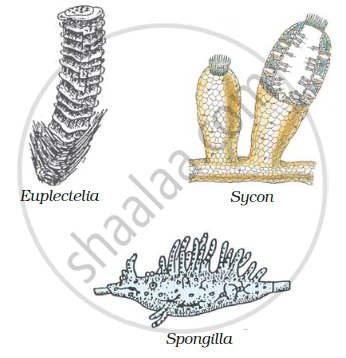Topics
Diversity of Living Organisms
The Living World
- What is ‘Living’?
- Diversity in the Living World
- Taxonomic Hierarchy of Living Organisms: Unit of Classification
- Three Domains of Life
- Taxonomical Aids
Biological Classification
Plant Kingdom
Animal Kingdom
Structural Organisation in Animals and Plants
Morphology of Flowering Plants
- Morphology and Modifications of Root, Stem, Leaf
- Types of Root
- Modifications of Roots for Storage, Respiration (Pneumatophores) and Support (Stilt and Prop)
- Stems
- Shoot System
- Leaves
- Types of Leaves (Simple and Compound – Pinnate and Palmate)
- Phyllotaxy – Alternate, Opposite, Whorled (With an Example of Each)
- Modifications for Mechanical Support, Protection, Storage, Reproduction; Insectivorous Plant (Pitcher Plant, Venus-fly-trap
- Morphology of Flower, Fruit and Seed
- Types of Inflorescence (Racemose and Cymose)
- Structure of a Typical Flower
- Fruits to Be Classified into True and False, Structure of a Typical Fruit (Mango and Coconut)
- Structure of a Dicotyledonous Seed
- Non-Albuminous and Albuminous, Perisperm
- Description of Families – Solanaceae, Fabaceae and Liliaceae
Anatomy of Flowering Plants
- Meristems or Meristematic Tissues
- Permanent Tissue
- Epidermal Tissue System
- Internal Structure of Root, Stem, and Leaf
- Secondary Growth in Dicot Stem and Dicot Root (With the Help of Outline Diagrams)
- Formation of Annual Rings
- Activity of the Cambium and Cork Cambium
- Formation of Secondary Tissues
- Differences Between Heart Wood and Sap Wood
- Early Wood and Late Wood
- Definition of Bark
Structural Organisation in Animals
- Introduction of Structural Organisation in Animals
- Epithelial Tissue
- Connective Tissue
- Muscular Tissue
- Neural Tissue
- Morphology of Cockroach
- Location, Structure and Functions of Epithelial Tissues with Examples
- Types of Junctions
- Location and General Structure of Areolar Tissue
- Difference Between Bone and Cartilage
- T.S. of Hyaline Cartilage and Bone
- Different Types of Muscles and Their Functions
- Anatomy of Cockroach
Cell: Structure and Function
Cell - The Unit of Life
- Cell Theory
- Structure of Prokaryotic and Eukaryotic Cells
- Plant Cell and Animal Cell
- Structure and Functions of Cell Envelope, Cell Membrane, Cell Wall, Cell Organelles
- Endomembrane System
- Mitochondria
- Ribosomes
- Plastids
- Microbodies
- Cytoskeleton
- Cilia and Flagella
- Centrosome and Centrioles
- Nucleus
Biomolecules
Cell Cycle and Cell Division
Plant Physiology
Transport in Plants
- Introduction of Transport in Plants
- Movement of Water, Gases and Nutrients
- Cell to Cell Transport
- Simple Diffusion
- Facilitated Diffusion
- Active Transport
- Osmosi
- Water Potential (ψ)
- Turgidity and Flaccidity (Plasmolysis)
- Introduction of Long Distance Transport of Water
- Uptake of Mineral Ions
- Structure of Stomatal Apparatus
- Concept of Plant-water Relations
- Diffusion of Gases
- Transport in Plants (Numericals)
Mineral Nutrition
- Plant Mineral Nutrition
- Elementary Idea of Hydroponics
- Criteria for Essentiality
- Macro and Micro Nutrients and Their Role
- Nitrogen Metabolism
- Nitrogen Cycle
- Nitrogen to Ammonia Conversion and Nitrogenase
- Deficiency Symptoms of Essential Elements
- Toxicity of Micronutrients
Photosynthesis in Higher Plants
- Early Experiments on Photosynthesis
- Photosynthesis Reaction
- Electron Transport - Cyclic and Non-cyclic Photo-phosphorylation
- Pigments Are Involved in Photosynthesis
- Photochemical and Biosynthetic Phases of Photosynthesis
- Photosynthesis as a Mean of Autotrophic Nutrition
- Site of Photosynthesis
- Photorespiration
- Light-independent Reactions
- Factors Affecting Photosynthesis
Respiration in Plants
- Respiration in Plant
- Phases of Respiration: Glycolysis
- Exchange of Gases - in Plants
- Oxidation of Pyruvate
- Types of Respiration: Aerobic and Anaerobic Respiration
- Phases of Respiration: Tricarboxylic Acid Cycle (Citric Acid Cycle Or Kreb’s Cycle)
- Energy Relations - Number of ATP Molecules Generated
- Phases of Respiration: Fermentation
- Respiratory Quotient (R.Q.)
- Amphibolic Pathways
Plant Growth and Development
- Introduction of Plant Growth and Development
- Plant Growth Generally is Indeterminate
- Phases of Plant Growth
- Differentiation, Dedifferentiation and Redifferentiation
- Characteristics of Growth Regulators
- Photoperiodism
- Formation of Seed and Fruit
- Conditions Necessary for Plant Growth
- Concept of Development
- Formation of Seed and Fruit
- Vernalisation
Human Physiology
Digestion and Absorption
- Alimentary Canal
- Role of Digestive Enzymes and Gastrointestinal Hormones
- Peristalsis, Digestion, Absorption and Assimilation of Proteins, Carbohydrates and Fats
- Calorific Values of Proteins
- Calorific Values of Carbohydrates
- Calorific Values of Fats
- Egestion of Food
- Nutritional and Digestive Tract Disorders
Breathing and Exchange of Gases
Body Fluids and Circulation
- Introduction of Body Fluids and Circulation
- Function of Platelets - Clotting of Blood (Coagulation)
- Blood Transfusion and Blood Groups (ABO and Rh system)
- Lymph and Lymphatic System
- Human Circulatory System
- Cardiac Cycle
- Types of Closed Circulation
- Electrocardiograph (ECG)
- Regulation of Cardiac Activity
- Disorders of Circulatory System
- Cardiac Output
Excretory Products and Their Elimination
- Modes of Excretion: Ammonotelism, Ureotelism, and Uricotelism
- Modes of Excretion: Ammonotelism, Ureotelism, and Uricotelism
- Modes of Excretion: Ammonotelism, Ureotelism, and Uricotelism
- Human Excretory System
- Function of the Kidney - “Production of Urine”
- Osmoregulation
- Regulation of Kidney Function
- Accessory Excretory Organs
- Common Disorders of the Urinary System
- Dialysis and Artificial Kidney
Locomotion and Movement
Neural Control and Coordination
Chemical Co-ordination and Integration
- Introduction of Chemical Coordination and Integration
- Human Endocrine System
- The Hypothalamus
- Mechanism of Hormone Action
- Role of Hormones as Messengers and Regulators
- Hypo and Hyperactivity and Related Disorders
- Kingdom Animalia
- Characteristics of Kingdom Animalia
Notes
Animalia
Kingdom Animalia is composed of all animals. The animal kingdom is the largest kingdom among the five kingdoms. Animals are multicellular eukaryotes. But they don’t have a cell wall or chlorophyll like plants. Hence, members of the animal kingdom have a heterotrophic mode of nutrition. Kingdom Animalia has been classified into 10 different subphyla based on their body design or differentiation.
The different subphylum of the animal kingdom are as follows:
-
Porifera
-
Coelenterata (Cnidaria)
-
Platyhelminthes
-
Nematoda
-
Annelida
-
Arthropoda
-
Mollusca
-
Echinodermata
-
Protochordata
-
Vertebrata
Porifera
Porifera means organisms with holes. They are commonly known as Sponges. Features of the poriferan are:
-
Non-motile, multicellular organisms with the hard outer skeleton.
-
Have a porous body.
-
Pores on the bodies create a canal system which helps in the circulation of substances.
-
Not differentiated into head and tail; don’t have a well-developed organ or organ system.
-
Include Marine Habitat.
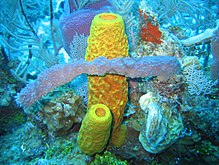
Example of subphylum Porifera includes- Spongilla, Sycon, etc.
Coelenterata (Cnidaria)
The term Coelenteratais derived from the Greek word “kilos” which means hollow-bellied. Their features are:
-
Have a hollow body cavity.
-
The body is differentiated into two ends.
-
Includes all aquatic animals.
-
The body is made of two layers of cells: inner and outer linings.
-
Live in colonies (corals) as well as solitary (Sea anemone).
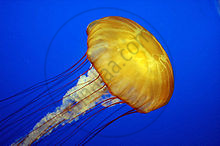
Example of subphylum Coelenterata includes – Hydra, Jellyfish, etc.
Platyhelminthes
Platyhelminthes are commonly known as flatworms. Their features are:
-
Dorsoventrally flattened body.
-
Complex and have differentiated body structure.
-
Tissues are differentiated from three layers of cells and are triploblastic.
-
Don’t have true internal cavity or coelom.
-
Have bilateral symmetry.
-
Either free-living (Planaria) or parasitic (Liver flukes).

Example of subphylum Platyhelminthes includes -Tapeworm, Planaria, etc.
Nematoda
Phylum Nematoda consists of nematodes or roundworms. Their features are:
-
Nematodes have a cylindrical body.
-
Bilaterally symmetrical and triploblastic.
-
Have pseudocoelom, a false body cavity.
-
Parasitic and causes diseases such as elephantiasis, ascariasis, etc.
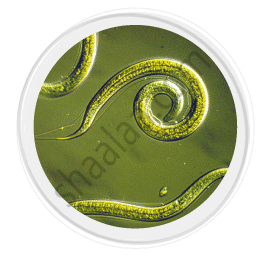
Example of subphylum Nematoda includes – Ascaris, Wuchereria, etc.
Annelida
Annelids are commonly known as segmented or ringed worms. They have the following features:
-
Have a segmented cylindrical body.
-
The body is differentiated into head and tail.
-
Bilaterally symmetrical and triploblastic.
-
Have a true body cavity.
-
Habitat: marine, freshwater, and land.

Example of subphylum Annelida includes – Earthworm, Leech, etC.
Arthropoda
Arthropod means jointed legs. Animals which have jointed appendages belong to this phylum. This is the largest phylum in the animal kingdom. Other features are:
-
They are bilaterally symmetrical.
-
Have jointed appendages, exoskeleton, and a segmented body.
-
Have well-differentiated organ and organ system.
-
Have an open circulatory system, but don’t have differentiated blood vessels.
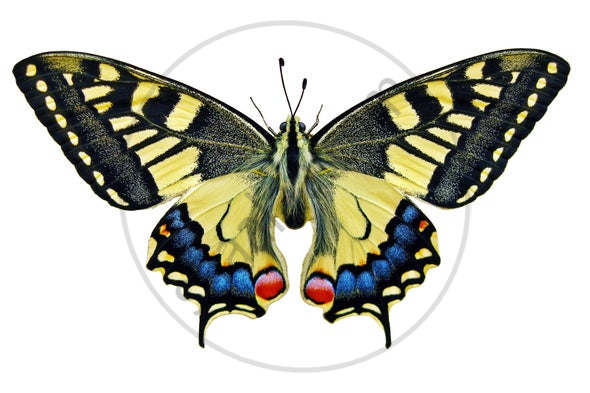
Example of subphylum Arthropoda includes – Spiders, butterflies, and mosquitoes.
Mollusca
Phylum Mollusca consists of a large group of animals. Features are:
-
Bilaterally symmetrical and triploblastic.
-
Less segmented body.
-
Well-developed organ and organ system.
-
Open circulatory system.
-
Limbs are present.
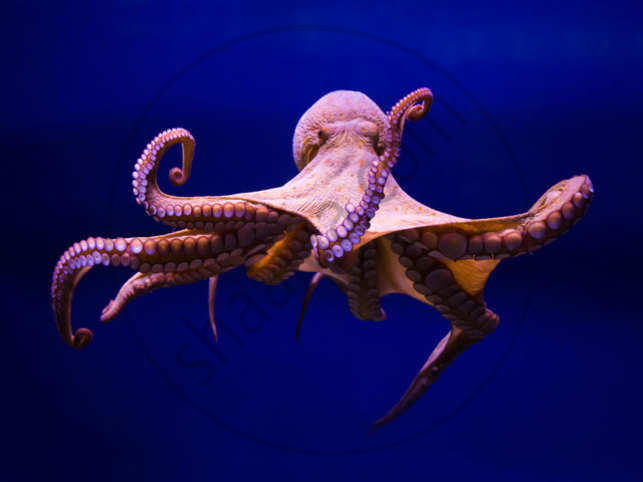
Example of subphylum Mollusca includes- Snails and octopus.
Echinodermata
The term Echinodermata is derived from the Greek words, echinos meaning hedgehog and derma meaning skin. Thus, echinoderms are spiny-skinned animals.
-
Radial symmetry and triploblastic.
-
Have true coelom.
-
Have hard calcium carbonate skeleton structure.
-
Free-living marine animals.
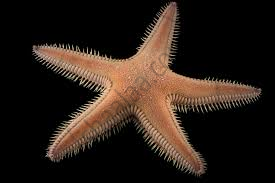
Example of subphylum Echinodermata includes- Sea urchins, starfish, etc.
Protochordate
Protochordates have the following features:
-
Bilaterally symmetrical and triploblastic.
-
Have true coelom.
-
Habitat: marine.
-
The notochord is present at some stages of lives.

Example of subphylum Protochordates includes- Balanoglossus, etc.
The notochord is a long supporting structure that separates the nervous tissues from the gut. It runs along the back of an animal and is a place for muscle attachment that helps in movement.
Vertebrata
Phylum Vertebrata consists of animals with a true vertebral column. They have an internal skeleton where muscles are attached and help in movement. Other features are:
-
Bilaterally symmetrical, triploblastic, coelomates and the segmented body.
-
The body design is complex and well-differentiated.
-
The body has an organ and organ system level of organization.
-
Possess notochord.
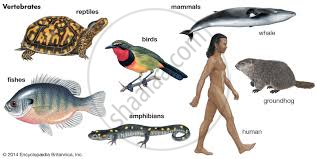
Vertebrates are further grouped into five classes.
- Pisces
- Cyclostomata
- Amphibia
- Reptilia
- Aves
- Mammalia
PISCES
- These are fish. They are exclusively aquatic animals. Their skin is covered with scales/ plates. They obtain oxygen dissolved in water by using gills.
- The body is streamlined, and a muscular tail is used for movement.
- They are cold-blooded and their hearts have only two chambers, unlike the four that humans have. They lay eggs.
- We can think of many kinds of fish, some with skeletons made entirely of cartilage, such as sharks, and some with a skeleton made of both bone and cartilage, such as tuna or rohu.
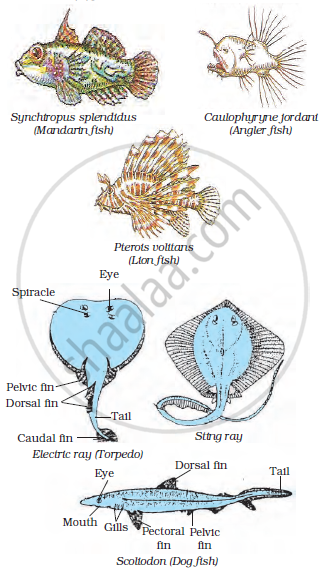
CYCLOSTOMATA
- Cyclostomes are jawless vertebrates. They are characterised by having an elongated eel-like body, circular mouth, slimy skin and are scaleless.
- They are ectoparasites or borers of other vertebrates.
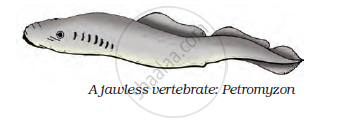
Example: Petromyzon (Lamprey) and Myxine (Hagfish)
AMPHIBIA
- These animals differ from the fish in the lack of scales, in having mucus glands in the skin, and a three-chambered heart.
- Respiration is through either gills or lungs.
- They lay eggs.
- These animals are found both in water and on land.
Frogs, toads and salamanders are some examples.
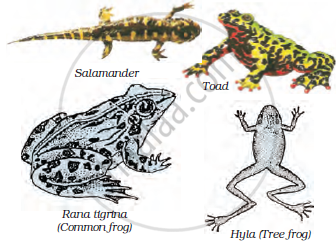
REPTILIA
- These animals are cold-blooded, have scales and breathe through lungs.
- While most of them have a three-chambered heart, crocodiles have four heart chambers.
- They lay eggs with tough coverings and do not need to lay their eggs in water, unlike amphibians.
- Snakes, turtles, lizards and crocodiles fall in this category.
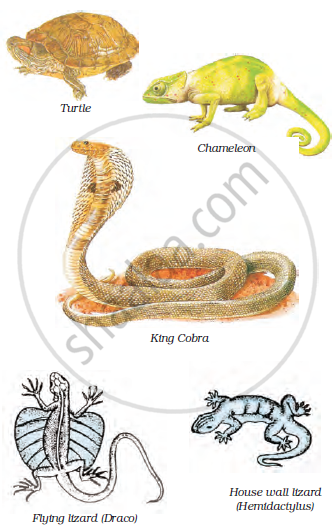
AVES
- These are warm-blooded animals and have a four chambered heart.
- They lay eggs.
- There is an outside covering of feathers, and two forelimbs are modified for flight.
- They breathe through lungs.
- All birds fall in this category.
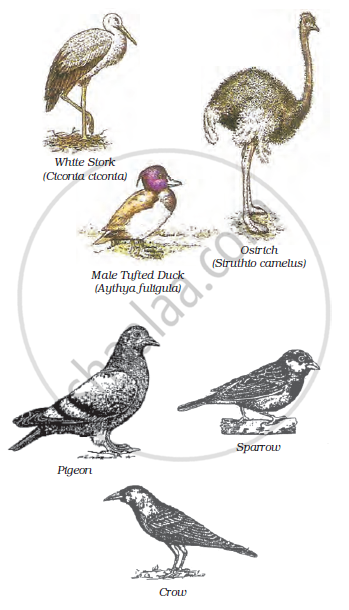
MAMMALIA
- Mammals are warm-blooded animals with four-chambered hearts.
- They have mammary glands for the production of milk to nourish their young.
- Their skin has hairs as well as sweat and oil glands.
- Most mammals familiar to us produce live young ones. However, a few of them, like the platypus and the echidna lay eggs, and some, like kangaroos give birth to very poorly developed young ones.

Notes
Animalia: Characteristics and basis of classification
-
Eukaryotic
-
Multicellular
-
Heterotrophic
-
Do not have cell-walls.
-
Most animals are mobile
Before starting the classification, let’s get familiar with few terms and the basis of criteria -
-
Grades of organization
-
Cellular grade organization - body made up of cells
-
Cell - tissue grade organization - body made up of cells forming tissues
-
Tissue-Organ grade - body made of tissues forming organs
-
Organ-system grade organization - body made of up of organs coming together (organ system)
-
-
Body symmetry
-
Asymmetry - there is no any such imaginary axis of the body through which we can get two equal halves
-
Radial symmetry - if imaginary cut passes through central axis but any plane of body, it gives two equal halves.
-
Bilateral symmetry - there is only one such imaginary axis of body through which we can get two equal halves.
-
-
Germ layers
-
Diploblastic - only two germ layers (endoderm and ectoderm)
-
Triploblastic - three germ layers (endoderm, mesoderm and ectoderm)
-
-
Body cavity (coelom)
-
Acoelomate - no body cavity
-
Pseudocoelomate - false body cavity (not present throughout the body)
-
Eucoelomate - true body cavity
-
-
Body segmentation
-
Non-segmented - body not divided into segments
-
True Segmented - body divided into small parts with repetition in organ in each part.
-
Pseudosegmented - segmented only externally and not internally.
-
1) Porifera:
-
Commonly called sponges
-
Organism with pores all over their body
-
Non-motile animals attached to some solid support.
-
Mainly found in marine habitats
-
‘Cellular grade organization
-
Mostly Asymmetric Body
-
Acoelomate
-
Body has spongin fibers
-
Water is taken in through ostia and given out through oscula.
-
They have good ability of regeneration.
-
Examples: Sycon, Euspongia
